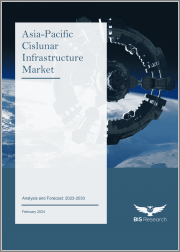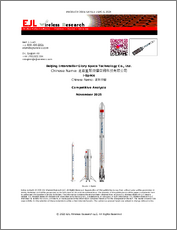
|
시장보고서
상품코드
1422244
아시아태평양의 시스루나 인프라 시장 : 분석과 예측(2023-2033년)Asia-Pacific Cislunar Infrastructure Market: Analysis and Forecast, 2023-2033 |
||||||
아시아태평양의 시스루나 인프라 시장 규모는 2023년 8억 1,000만 달러에서 2033년에는 24억 9,000만 달러에 달할 것으로 예측되며, 예측 기간인 2023-2033년의 성장률은 11.96%에 달할 것으로 보이고 있습니다.
시스루나 인프라 분야의 성장은 우주 기관, 민간기업, 파트너십에 의한 강력하고 환경적으로 지속가능한 시스루나 환경 구축에 대한 관심의 증가에 의해 추진되고 있습니다.
| 주요 시장 통계 | |
|---|---|
| 예측 기간 | 2023-2033년 |
| 2023년 평가 | 8억 1,000만 달러 |
| 2033년 예측 | 24억 9,000만 달러 |
| CAGR | 11.96% |
아시아태평양에서는 추진 시스템, 통신 시스템, 우주정거장, 우주 운송, 자원 이용 등 5가지 주요 요인으로 인해 태양계 인프라 개발이 탄력을 받고 있습니다. 추진 시스템, 통신 시스템, 우주정거장, 우주 운송, 자원 이용입니다. 추진시스템과 통신의 발전에는 많은 투자가 이루어졌지만, 현재는 우주정거장, 우주운송, 자원이용의 문제 해결에 더 많은 관심이 집중되고 있습니다. 아시아태평양의 우주 탐사 및 협력에 대한 헌신은 지속가능한 태양계 존재에 대한 관심을 높이고 있습니다. 최근 발전에는 추진력 개선과 재사용 가능한 발사체 개발이 포함됩니다. 현재는 신뢰할 수 있는 통신과 우주 운송 솔루션에 대한 수요를 충족시키는 데 중점을 두고 있습니다. 시스루너 인프라는 장기 달 탐사, 과학 탐사 및 잠재적 천체 벤처에 매우 중요하며, 시스루나의 특수한 환경에 맞게 설계되어 안전한 운영과 자원 활용을 가능하게 하고 시장 성장을 지원하고 있습니다.
아시아태평양의 시스루나 인프라 시장에 대해 조사했으며, 시장의 개요와 기술별, 국가별 동향 및 시장에 참여하는 기업의 개요 등을 제공하고 있습니다.
목차
주요 요약
조사 범위
제1장 시장
- 업계의 전망
- 비즈니스 역학
제2장 지역
- 태고 인프라 시장(지역별)
- 아시아태평양
- 시장
- 제품
- 아시아태평양(국가별)
제3장 시장 - 경쟁 벤치마킹과 기업 개요
- 경쟁 벤치마킹
- 주요 진출 기업 개요
제4장 조사 방법
KSA 24.02.19“The Asia-Pacific Cislunar Infrastructure Market Expected to Reach $2.49 Billion by 2033.”
Introduction to Asia-Pacific Cislunar Infrastructure Market
The Asia-Pacific cislunar infrastructure market is estimated to reach $2.49 billion by 2033 from $0.81 billion in 2023, at a growth rate of 11.96% during the forecast period 2023-2033. The growth of the cislunar infrastructure sector is propelled by a growing fascination from space agencies, private enterprises, and partnerships in building a strong and environmentally sustainable cislunar environment.
| KEY MARKET STATISTICS | |
|---|---|
| Forecast Period | 2023 - 2033 |
| 2023 Evaluation | $0.81 Billion |
| 2033 Forecast | $2.49 Billion |
| CAGR | 11.96% |
Market Introduction
In APAC, cislunar infrastructure development is gaining momentum due to five key factors: propulsion systems, communication systems, space stations, in-space transportation, and resource utilization. Progress in propulsion and communication has seen substantial investment, while attention is now shifting to address challenges in space stations, in-space transport, and resource use. APAC region's commitment to space exploration and collaboration fuels interest in a sustainable cislunar presence. Recent progress includes improved propulsion and reusable launch vehicles. Efforts now focus on reliable communication and meeting demand for in-space transport solutions. Cislunar infrastructure is crucial for long lunar missions, scientific exploration, and potential celestial body ventures, designed for the unique cislunar environment to enable safe operations and resource utilization, supporting market growth.
Market Segmentation:
Segmentation 1: by Technology
- Propulsion Systems
- Communication Systems (Relay Satellites)
- Space Stations
- In-Space Transportation Vehicles
Segmentation 2: by Country
- China
- Japan
- India
- Rest-of-Asia-Pacific
How can this report add value to an organization?
Product/Innovation Strategy: The product segment helps the reader to understand the different types of solutions available for deployment and their potential. Moreover, the study provides the reader with a detailed understanding of the cislunar infrastructure market by technology, inclusive of the key developments in the respective segments.
Growth/Marketing Strategy: The cislunar infrastructure market has seen some major development by key players operating in the market, such as partnership, collaboration, and joint venture. The favored strategy for the collaboration between government space agencies and private players is primordially contracting the development and delivery of the key segments of the cislunar infrastructure ecosystem.
Table of Contents
Executive Summary
Scope of the Study
1. Market
- 1.1. Industry Outlook
- 1.1.1. Cislunar Infrastructure Market: Overview
- 1.1.2. Ongoing and Upcoming Programs
- 1.1.2.1. NASA's Lunar Orbital Platform-Gateway
- 1.1.2.2. ESA's Moonlight Initiative
- 1.1.2.3. ULA Cislunar-1000
- 1.1.2.4. China National Space Administration's (CNSA) International Lunar Research Station (ILRS)
- 1.1.2.5. CSA's Lunar Exploration Accelerator Program (LEAP)
- 1.1.3. Startups and Investment Landscape
- 1.1.4. Supply Chain Analysis
- 1.1.5. Value Chain Analysis
- 1.2. Business Dynamics
- 1.2.1. Business Drivers
- 1.2.1.1. Demand for Lunar Resources
- 1.2.1.2. Strategic Importance of Cislunar Space
- 1.2.2. Business Challenges
- 1.2.2.1. Cislunar Regulations
- 1.2.2.2. Challenges in Energy Collection and Distribution for Cislunar Infrastructure Requirements
- 1.2.2.3. Constraints in International Partnership
- 1.2.3. Business Strategies
- 1.2.3.1. Mergers and Acquisitions
- 1.2.4. Corporate Strategies
- 1.2.4.1. Partnerships, Collaborations, Agreements, and Contracts
- 1.2.5. Business Opportunities
- 1.2.5.1. Need for Situational Awareness and Communications Infrastructure
- 1.2.5.2. Inter-Orbital Transportation and Cislunar Surface Transportation
- 1.2.5.3. Requirement for On-Orbit Servicing
- 1.2.1. Business Drivers
2. Region
- 2.1. Cislunar Infrastructure Market (by Region)
- 2.2. Asia-Pacific
- 2.2.1. Market
- 2.2.1.1. Key Players in Asia-Pacific
- 2.2.1.2. Business Drivers
- 2.2.1.3. Business Challenges
- 2.2.2. Product
- 2.2.2.1. Asia-Pacific Cislunar Infrastructure Market (by Technology)
- 2.2.3. Asia-Pacific (by Country)
- 2.2.3.1. China
- 2.2.3.1.1. Market
- 2.2.3.1.1.1. Key Players in China
- 2.2.3.1.2. Product
- 2.2.3.1.2.1. China Cislunar Infrastructure Market (by Technology)
- 2.2.3.1.1. Market
- 2.2.3.2. India
- 2.2.3.2.1. Market
- 2.2.3.2.1.1. Key Players in India
- 2.2.3.2.2. Product
- 2.2.3.2.2.1. India Cislunar Infrastructure Market (by Technology)
- 2.2.3.2.1. Market
- 2.2.3.3. Japan
- 2.2.3.3.1. Market
- 2.2.3.3.1.1. Key Players in Japan
- 2.2.3.3.2. Product
- 2.2.3.3.2.1. Japan Cislunar Infrastructure Market (by Technology)
- 2.2.3.3.1. Market
- 2.2.3.4. Rest-of-Asia-Pacific
- 2.2.3.4.1. Market
- 2.2.3.4.1.1. Key Players in Rest-of-Asia-Pacific
- 2.2.3.4.2. Product
- 2.2.3.4.2.1. Rest-of-Asia-Pacific Cislunar Infrastructure Market (by Technology)
- 2.2.3.4.1. Market
- 2.2.3.1. China
- 2.2.1. Market
3. Market - Competitive Benchmarking & Company Profiles
- 3.1. Competitive Benchmarking
- 3.2. Key Player Profiles
4. Research Methodology
- 4.1. Factors for Data Prediction and Modeling



















